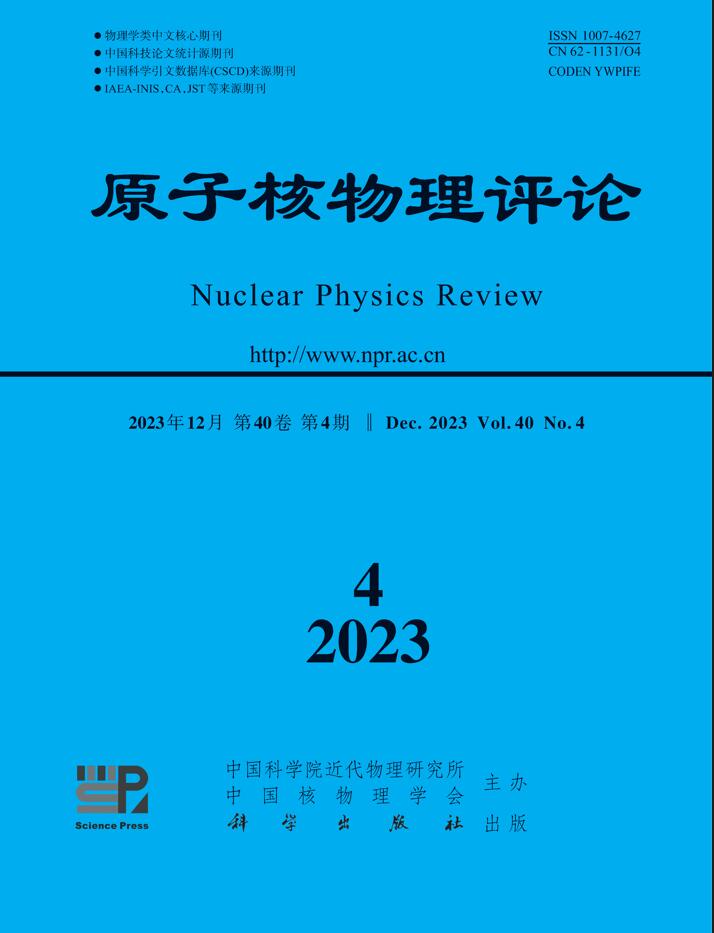2001 Vol. 18, No. 2

Display Method:
2001, 18(2): 65-71.
doi: 10.11804/NuclPhysRev.18.02.065
Abstract:
A new interesting field —— magnetic rotation physics is reviewed. It is proved that the tilted axis cranking (TAC) model is equivalence to the particle rotor model (PRM) under the semi classical and mean field approximations. The shears mechanism and the new discovered phenomena in triaxial deformed nuclei—— chiral doublets are discussed. The possible mass region for these magnetic rotation phenomena is presented.
A new interesting field —— magnetic rotation physics is reviewed. It is proved that the tilted axis cranking (TAC) model is equivalence to the particle rotor model (PRM) under the semi classical and mean field approximations. The shears mechanism and the new discovered phenomena in triaxial deformed nuclei—— chiral doublets are discussed. The possible mass region for these magnetic rotation phenomena is presented.
2001, 18(2): 72-79.
doi: 10.11804/NuclPhysRev.18.02.072
Abstract:
The experimental study and the theoretical development on the structures of excitation functions in dissipative heavy ion collisions last years were reviewed. Especially the long range angular correlation in the reaction of 27Al+ 27Al and the non reproducibility of the cross sections measured in the reaction of 19 F+ 93 Nb were introduced. The experimental results indicate that the angular coherent width in the dissipative...
The experimental study and the theoretical development on the structures of excitation functions in dissipative heavy ion collisions last years were reviewed. Especially the long range angular correlation in the reaction of 27Al+ 27Al and the non reproducibility of the cross sections measured in the reaction of 19 F+ 93 Nb were introduced. The experimental results indicate that the angular coherent width in the dissipative...
2001, 18(2): 80-84.
doi: 10.11804/NuclPhysRev.18.02.080
Abstract:
Observables that related to the impact parameters in intermediate and relativistic energy heavy ion reactions were introduced. These observables that related to the impact parameter include linear momentum transfer, multiplicities of charged particles, the ratio of transverse kinetic energy and longitudinal kinetic energy E rat , the transverse momentum directivity, Z bound , elliptic flow etc. Impact parameter determination for intermediate and relativistic energy heavy...
Observables that related to the impact parameters in intermediate and relativistic energy heavy ion reactions were introduced. These observables that related to the impact parameter include linear momentum transfer, multiplicities of charged particles, the ratio of transverse kinetic energy and longitudinal kinetic energy E rat , the transverse momentum directivity, Z bound , elliptic flow etc. Impact parameter determination for intermediate and relativistic energy heavy...
2001, 18(2): 85-90.
doi: 10.11804/NuclPhysRev.18.02.085
Abstract:
The recent developments of rotational spectral theories and its application to superdeformed bands were briefly reviewed. The superdeformed bands in A ≈190 region were analyzed and the spins of energy level were determined by the least square fitting experimental transition energy with the formula of Bohr Mottelson’s I(I+1) expansions. The superdeformed bands in A ≈150 region were analyzed by using the kinematic moments of inertia formula J (1) =2α+(4/3)βω 2+(6/5)γω 4 in...
The recent developments of rotational spectral theories and its application to superdeformed bands were briefly reviewed. The superdeformed bands in A ≈190 region were analyzed and the spins of energy level were determined by the least square fitting experimental transition energy with the formula of Bohr Mottelson’s I(I+1) expansions. The superdeformed bands in A ≈150 region were analyzed by using the kinematic moments of inertia formula J (1) =2α+(4/3)βω 2+(6/5)γω 4 in...
2001, 18(2): 91-95.
doi: 10.11804/NuclPhysRev.18.02.091
Abstract:
The great successes of cold fusion reaction which was suggested as the most important production mechanism for superheavy element of Z >106, as the well as the main hot point problems in recent research of superheavy element synthesis are reviewed. Some different opinions around the synthesis of the superheavy element of Z =118 and the further prospect of utilizing cold fusion reactions to the syntheses of superheavy elements of Z >112 are introduced in detail...
The great successes of cold fusion reaction which was suggested as the most important production mechanism for superheavy element of Z >106, as the well as the main hot point problems in recent research of superheavy element synthesis are reviewed. Some different opinions around the synthesis of the superheavy element of Z =118 and the further prospect of utilizing cold fusion reactions to the syntheses of superheavy elements of Z >112 are introduced in detail...
2001, 18(2): 96-100.
doi: 10.11804/NuclPhysRev.18.02.096
Abstract:
The Large Hadron Collider (LHC) at the European Laboratory for Particle Physics (CERN) is expected to operate at the luminosity of 10 34 /(cm 2 ·s), and the resulting background condition in the experimental hall would be quit severe. Thin Gap Chamber (TGC) will be used for forward muon triggering in the ATLAS experiment. According to a simulation, the main source of the background around TGC in the experimental hall is neutrons and photons. The sensitivity measurement for TGC...
The Large Hadron Collider (LHC) at the European Laboratory for Particle Physics (CERN) is expected to operate at the luminosity of 10 34 /(cm 2 ·s), and the resulting background condition in the experimental hall would be quit severe. Thin Gap Chamber (TGC) will be used for forward muon triggering in the ATLAS experiment. According to a simulation, the main source of the background around TGC in the experimental hall is neutrons and photons. The sensitivity measurement for TGC...
2001, 18(2): 101-104.
doi: 10.11804/NuclPhysRev.18.02.101
Abstract:
In order to meet the meeds of nuclear physic research, the beam intensity of RIBLL (Radioactivy Ion Beam Line in Lanzhou) should be improued. This can be carried out by two ways: increasing the primary beam intensity or improuing the transmission of the beam line. A system consisting of three superconducting solenoids and a new target frame is designed.
In order to meet the meeds of nuclear physic research, the beam intensity of RIBLL (Radioactivy Ion Beam Line in Lanzhou) should be improued. This can be carried out by two ways: increasing the primary beam intensity or improuing the transmission of the beam line. A system consisting of three superconducting solenoids and a new target frame is designed.
2001, 18(2): 105-108.
doi: 10.11804/NuclPhysRev.18.02.105
Abstract:
In order to obtain the tolerance requirement for the magnetic field homogeneity of the solenoids in electron cooling device, the source of the magnetic imperfection and its influence on the transverse temperature of electron beam were investigated by means of numerical simulation, and taking the space charge effect of electron beam into account. The calculated result shows that the influence of the imperfection of magnetic field will be negligible when the relative magnetic field...
In order to obtain the tolerance requirement for the magnetic field homogeneity of the solenoids in electron cooling device, the source of the magnetic imperfection and its influence on the transverse temperature of electron beam were investigated by means of numerical simulation, and taking the space charge effect of electron beam into account. The calculated result shows that the influence of the imperfection of magnetic field will be negligible when the relative magnetic field...
2001, 18(2): 109-115.
doi: 10.11804/NuclPhysRev.18.02.109
Abstract:
The conformal radiotherapy techniques mainly include the two systems that are beam delivery and treatment planning. The formal is the hardware basis while the later is the software supplement for heavy ion conformal therapy, they are dependent on each other to realize the cancer conformal therapy with heavy ion beam. Because of the specificities of interaction between heavy ion and target on both physics and biological effects, the heavy ion cancer therapy especially involves...
The conformal radiotherapy techniques mainly include the two systems that are beam delivery and treatment planning. The formal is the hardware basis while the later is the software supplement for heavy ion conformal therapy, they are dependent on each other to realize the cancer conformal therapy with heavy ion beam. Because of the specificities of interaction between heavy ion and target on both physics and biological effects, the heavy ion cancer therapy especially involves...
2001, 18(2): 116-119.
doi: 10.11804/NuclPhysRev.18.02.116
Abstract:
A simple plane rotating gantry is proposed at the Heavy Ion Research Facility in Lanzhou (HIRFL), where a new project named Cooling Storage Ring is under construction. The gantry is 18 metre long, 5 metre high from upper beam axes to rotation axes. It consists of eight quadruples, two 45° and one large aperture 90° dipole magnets. It is equipped with a two direction magnetic raster scanning system. A beam spot of radii between 2 to 5 mm can be achieved at∶...
A simple plane rotating gantry is proposed at the Heavy Ion Research Facility in Lanzhou (HIRFL), where a new project named Cooling Storage Ring is under construction. The gantry is 18 metre long, 5 metre high from upper beam axes to rotation axes. It consists of eight quadruples, two 45° and one large aperture 90° dipole magnets. It is equipped with a two direction magnetic raster scanning system. A beam spot of radii between 2 to 5 mm can be achieved at∶...
2001, 18(2): 120-124.
doi: 10.11804/NuclPhysRev.18.02.120
Abstract:
The results of the diamond like carbon films(the following is called for short DLC film) irradiated by γ rays and N ion were reported. It showed that SP 3C—H and SP 2C—H bonds were decreased, and SP 3C—C bonds were increased by γ ray irradiation, and induced hydrogen recombination with H 2 molecules, and subsequently released from the surface of the films. When the γ ray irradiation dose reached 10×104Gy, the numbers of SP3C—H bonds were decreased by about 50%...
The results of the diamond like carbon films(the following is called for short DLC film) irradiated by γ rays and N ion were reported. It showed that SP 3C—H and SP 2C—H bonds were decreased, and SP 3C—C bonds were increased by γ ray irradiation, and induced hydrogen recombination with H 2 molecules, and subsequently released from the surface of the films. When the γ ray irradiation dose reached 10×104Gy, the numbers of SP3C—H bonds were decreased by about 50%...
2001, 18(2): 125-128.
doi: 10.11804/NuclPhysRev.18.02.125
Abstract:
Secondary radiation such as neutrons, high energy light particees, γ rays is produced when ion beams with medium energy irradiate biological materials. Spring wheat was placed in radiobiological experiment area(irradiation terminal L2) to expose to the secondary radiation. The variation of M1 generation of the wheat seeds was obtained through test in the fields and measuremeat in laboratery: (1) There were very high variation rates in grain number, number of small...
Secondary radiation such as neutrons, high energy light particees, γ rays is produced when ion beams with medium energy irradiate biological materials. Spring wheat was placed in radiobiological experiment area(irradiation terminal L2) to expose to the secondary radiation. The variation of M1 generation of the wheat seeds was obtained through test in the fields and measuremeat in laboratery: (1) There were very high variation rates in grain number, number of small...







 甘公网安备 62010202000723号
甘公网安备 62010202000723号